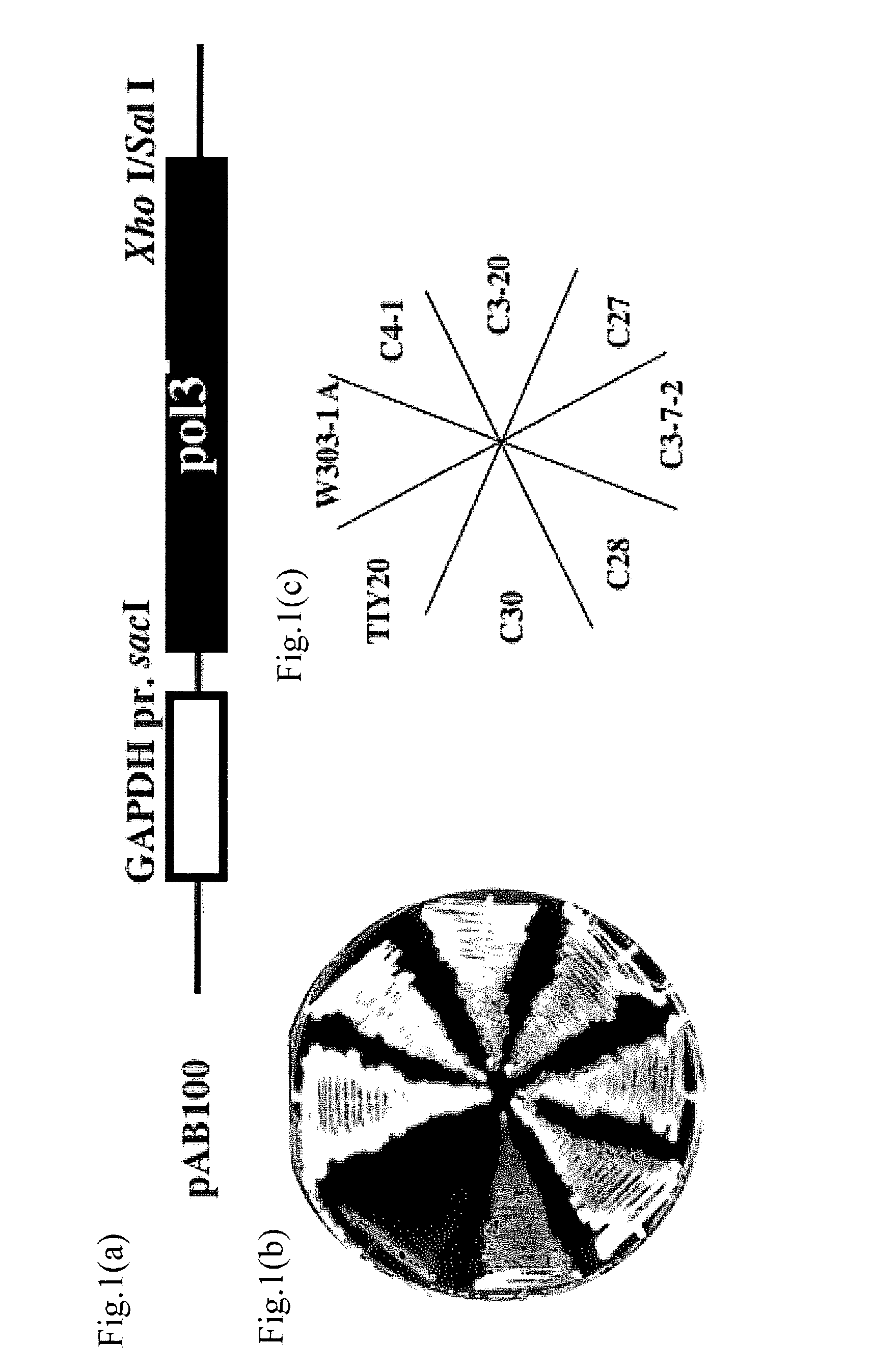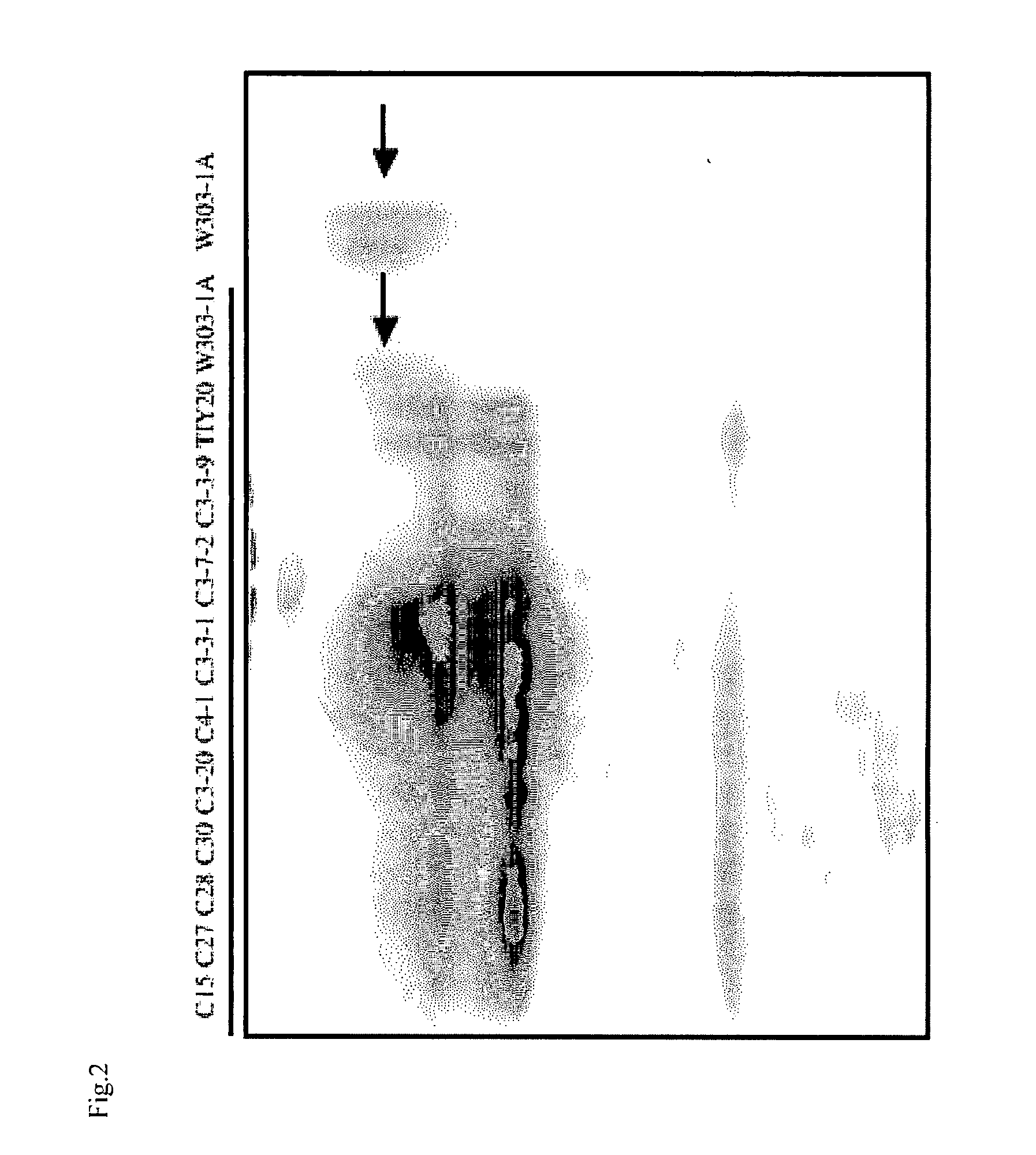Breeding method for yeast, yeast and a production method for glycoprotein or beta-glucan
a production method and yeast technology, applied in the field of breeding methods for yeast, can solve the problems of defective growth, low protein productivity, and insufficient glycoprotein production of yeast glycoproteins for drugs
- Summary
- Abstract
- Description
- Claims
- Application Information
AI Technical Summary
Benefits of technology
Problems solved by technology
Method used
Image
Examples
example 1
Construction of Plasmid pAB100 Inserted Mutated pol3 DNA Fragment
[0098]As follows, plasmid pAB100 (see FIG. 1(a)) was constructed by inserting a mutated pol3 fragment into SacI-SalI site of multicopy expression vector YEP352GAP2 for forced expression in budding yeast. Amino acid sequence of Pol3 is shown in sequence number 1 and DNA sequence coding Pol3 is shown in sequence number 2. A pol3-01 mutant gene obtained by this example is one in which 962nd base A in sequence number 2 is substituted by C and in which 968th base A in sequence number 2 is substituted by C. That is to say, a mutation was introduced in which amino acid residue coded by DNA sequence from 961st to 969th shown in sequence number 2 has DIE substituted by AlA. Thus obtained amino acid sequence of pol3-01 is shown in sequence number 3 and DNA sequence coding pol3-01 mutant gene is shown in DNA sequence 4. To explain it specifically, using genome of AMY128-1 strain (MAT α pol3-01, ura3-52, leu2-1, lys1-1, ade2-1, hi...
example 3
Analysis of Sugar Chain Structure
[0102]Sugar chain structure of mannoprotein in the strain obtained in example 1 was analyzed. The yeast cultured in 50 ml scale was collected, and was washed with water. Then, the yeast was suspended in 8 ml of 100 mM citrate buffer (pH7.0) and was autoclaved at 121 degrees C. for 2 hours. Supernatant was recovered by centrifugation, was added with 24 ml of cold ethanol and stand for 30 min. at −20 degrees C. After standing, the supernatant was centrifuged and its precipitation was recovered. The precipitation was suspended in water. Protein solution was prepared to 3 mg / ml and was treated with 5 micro litter of Glycopeptidase F (Takara Bio Co. Inc. 4450). After incubation at 37 degrees C. for 17 hours, it was added with water to 100 micro litter, was added with phenol:chloroform:isoamylalcohol (25:24:1), was mixed well and supernatant was recovered by centrifugation (extraction of phenol / chloroform). After chloroform was added to recovered solution ...
example 4
Chitinase Analysis
[0103]An efficiency of secretion of the protein secreted from the strain obtained in example 1 was analyzed. To supernatant of 40 ml culture yeast, 40 mg of wet chitin (Sigma) was added and stirred overnight at 4 degrees C. Chitin was recovered by centrifugation and was washed 3 times with PBS. It was suspended in 100 micro litter of SDS-PAGE sample buffer, treated at 100 degrees C. for 10 min, 10 micro litter of the chitin was electrophoresed by SDS-PAGE and lectin blotted using ConA-biotin (Seikagaku Kogyo Co.). The blotting was detected using by Streptaridin-HRP (Seikagaku Kogyo) As a detection reagent, Immobilon Western Chemiluminescent HRP Substrate (Millipore) was used and Fuji film LAS1000 was used as a detection apparatus. The result is shown in FIG. 5. FIG. 5 is a graph as an alternative of a figure to show a secretion efficiency of protein which is secreted from the mutant strain. From FIG. 5, although the efficiency of secretion is 50% of that of wild-ty...
PUM
| Property | Measurement | Unit |
|---|---|---|
| pH | aaaaa | aaaaa |
| pH | aaaaa | aaaaa |
| temperature sensitivity | aaaaa | aaaaa |
Abstract
Description
Claims
Application Information
 Login to View More
Login to View More - R&D
- Intellectual Property
- Life Sciences
- Materials
- Tech Scout
- Unparalleled Data Quality
- Higher Quality Content
- 60% Fewer Hallucinations
Browse by: Latest US Patents, China's latest patents, Technical Efficacy Thesaurus, Application Domain, Technology Topic, Popular Technical Reports.
© 2025 PatSnap. All rights reserved.Legal|Privacy policy|Modern Slavery Act Transparency Statement|Sitemap|About US| Contact US: help@patsnap.com



